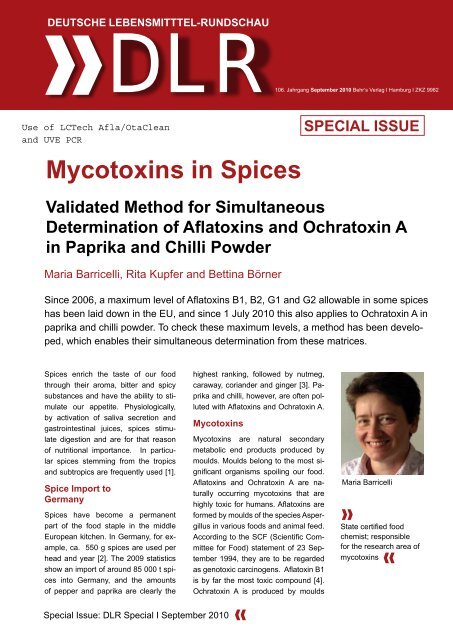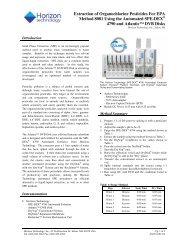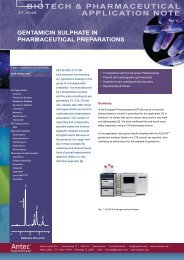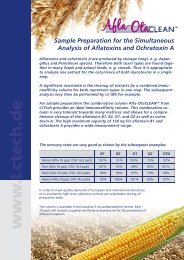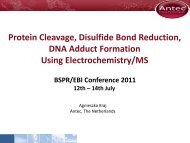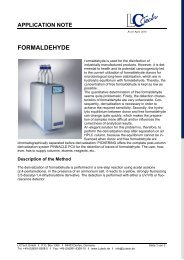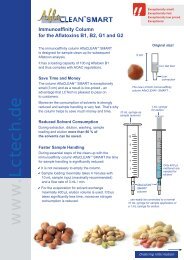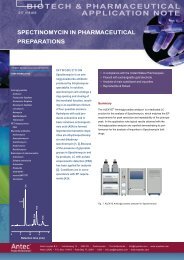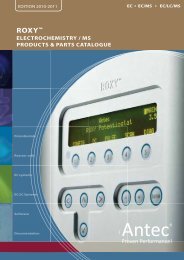SPECIAL ISSUE Mycotoxins in Spices Validated Method for ...
SPECIAL ISSUE Mycotoxins in Spices Validated Method for ...
SPECIAL ISSUE Mycotoxins in Spices Validated Method for ...
You also want an ePaper? Increase the reach of your titles
YUMPU automatically turns print PDFs into web optimized ePapers that Google loves.
DEUTSCHE LEBENSMITTTEL-RUNDSCHAU<br />
DLR106. Jahrgang September 2010 Behr‘s Verlag I Hamburg I ZKZ 9982<br />
<strong>Mycotox<strong>in</strong>s</strong> <strong>in</strong> <strong>Spices</strong><br />
<strong>SPECIAL</strong> <strong>ISSUE</strong><br />
<strong>Validated</strong> <strong>Method</strong> <strong>for</strong> Simultaneous<br />
Determ<strong>in</strong>ation of Aflatox<strong>in</strong>s and Ochratox<strong>in</strong> A<br />
<strong>in</strong> Paprika and Chilli Powder<br />
Maria Barricelli, Rita Kupfer and Bett<strong>in</strong>a Börner<br />
S<strong>in</strong>ce 2006, a maximum level of Aflatox<strong>in</strong>s B1, B2, G1 and G2 allowable <strong>in</strong> some spices<br />
has been laid down <strong>in</strong> the EU, and s<strong>in</strong>ce 1 July 2010 this also applies to Ochratox<strong>in</strong> A <strong>in</strong><br />
paprika and chilli powder. To check these maximum levels, a method has been developed,<br />
which enables their simultaneous determ<strong>in</strong>ation from these matrices.<br />
<strong>Spices</strong> enrich the taste of our food<br />
through their aroma, bitter and spicy<br />
substances and have the ability to stimulate<br />
our appetite. Physiologically,<br />
by activation of saliva secretion and<br />
gastro<strong>in</strong>test<strong>in</strong>al juices, spices stimulate<br />
digestion and are <strong>for</strong> that reason<br />
of nutritional importance. In particular<br />
spices stemm<strong>in</strong>g from the tropics<br />
and subtropics are frequently used [1].<br />
Spice Import to<br />
Germany<br />
<strong>Spices</strong> have become a permanent<br />
part of the food staple <strong>in</strong> the middle<br />
European kitchen. In Germany, <strong>for</strong> example,<br />
ca. 550 g spices are used per<br />
head and year [2]. The 2009 statistics<br />
show an import of around 85 000 t spices<br />
<strong>in</strong>to Germany, and the amounts<br />
of pepper and paprika are clearly the<br />
Special Issue: DLR Special I September 2010<br />
highest rank<strong>in</strong>g, followed by nutmeg,<br />
caraway, coriander and g<strong>in</strong>ger [3]. Paprika<br />
and chilli, however, are often polluted<br />
with Aflatox<strong>in</strong>s and Ochratox<strong>in</strong> A.<br />
<strong>Mycotox<strong>in</strong>s</strong><br />
<strong>Mycotox<strong>in</strong>s</strong> are natural secondary<br />
metabolic end products produced by<br />
moulds. Moulds belong to the most significant<br />
organisms spoil<strong>in</strong>g our food.<br />
Aflatox<strong>in</strong>s and Ochratox<strong>in</strong> A are naturally<br />
occurr<strong>in</strong>g mycotox<strong>in</strong>s that are<br />
highly toxic <strong>for</strong> humans. Aflatox<strong>in</strong>s are<br />
<strong>for</strong>med by moulds of the species Aspergillus<br />
<strong>in</strong> various foods and animal feed.<br />
Accord<strong>in</strong>g to the SCF (Scientific Committee<br />
<strong>for</strong> Food) statement of 23 September<br />
1994, they are to be regarded<br />
as genotoxic carc<strong>in</strong>ogens. Aflatox<strong>in</strong> B1<br />
is by far the most toxic compound [4].<br />
Ochratox<strong>in</strong> A is produced by moulds<br />
Maria Barricelli<br />
State certified food<br />
chemist; responsible<br />
<strong>for</strong> the research area of<br />
mycotox<strong>in</strong>s
2<br />
Food Analysis<br />
Tab. 1 Parameter sett<strong>in</strong>gs of the ion source<br />
Polarity ES+<br />
Cone Voltage 28 V<br />
Source Temperature 100 °C<br />
Desolvation Temperature 400 °C<br />
Desolvation Gas 450 l/h<br />
Cone Gas 100 l/h<br />
Tab. 2 MRM-experiments of function 1<br />
Channel Reaction Dwell [s] Cone [V%] Collision<br />
1 404 > 239 0.2 28 24<br />
2 404 > 357,9 0.2 28 14<br />
Inter Channel Delay: 0.05 s; RT W<strong>in</strong>dow: 3-9 m<strong>in</strong><br />
Rita Kupfer<br />
Bsc Food chemist,<br />
hold<strong>in</strong>g a scientific<br />
placement with LLBB<br />
from July 2009 to end<br />
of August 2010<br />
Literature<br />
[1] Franke W: Nutzpflanzenkunde. 3.<br />
Aufl., Thieme Verlag, Stuttgart (1985).<br />
[2] afz-journal: Die Fleischerei,<br />
Lebensmittelpraxis. Blick/ff-delikat.<br />
[3] Source: Official Foreign Trade<br />
Statistics, prelim<strong>in</strong>ary results.<br />
[4] Berichte dese Wissenschaftlichen<br />
Lebensmittelausschusses, fünfunddreißigste<br />
Folge, Stellungnahme<br />
des Wissenschaftlichen Lebens-<br />
of the species Aspergillus and Penicillium<br />
on cereal, coffee, spices and<br />
other foods. The scientific committee<br />
<strong>for</strong> contam<strong>in</strong>ants <strong>in</strong> the food cha<strong>in</strong> of<br />
the European Food Safety Authority<br />
(EFSA) classed Ochratox<strong>in</strong> A, after an<br />
updated scientific survey on Ochratox<strong>in</strong><br />
A <strong>in</strong> foods of 4 April 2006, as a<br />
mycotox<strong>in</strong> with nephrotoxic and genotoxic<br />
characteristics. Due to an <strong>in</strong>complete<br />
set of data, the classification<br />
of Ochratox<strong>in</strong> A as kidney carc<strong>in</strong>ogen<br />
<strong>in</strong> humans could not be justified [5].<br />
Exam<strong>in</strong>ations<br />
S<strong>in</strong>ce 1987, different spice samples<br />
are cont<strong>in</strong>uously tested <strong>for</strong> Aflatox<strong>in</strong>s<br />
and Ochratox<strong>in</strong> A with<strong>in</strong> the framework<br />
of an official monitor<strong>in</strong>g body <strong>in</strong><br />
Berl<strong>in</strong>. It came to show that <strong>in</strong> particular<br />
paprika, closely followed by<br />
chilli powder, were the most frequent-<br />
mittelausschusses zu Aflatox<strong>in</strong>en,<br />
Ochratox<strong>in</strong> A und Patul<strong>in</strong>, s.45-50.<br />
http://ec.europa.eu/food/fs/sc/scf/reports/scf_reports_35.pdf<br />
[5] The EFSA Journal 365, 1-56<br />
(2006).<br />
[6] User Manual Afla-OtaCLEANTM :<br />
Immunoaff<strong>in</strong>ity columns <strong>for</strong> the<br />
analyis of Aflatox<strong>in</strong> B/G and<br />
Ochratox<strong>in</strong> A. LCTech GmbH, Dorfen,<br />
Germany, as of: October, 2009<br />
ly contam<strong>in</strong>ated with both Aflatox<strong>in</strong>s<br />
and Ochratox<strong>in</strong> A. Green, white and<br />
black pepper were only little or not at<br />
all polluted with these mycotox<strong>in</strong>s. The<br />
same applied to g<strong>in</strong>ger and nutmeg.<br />
<strong>Method</strong>ology<br />
Based on our exam<strong>in</strong>ation results, <strong>in</strong><br />
order to test <strong>for</strong> maximum levels of Aflatox<strong>in</strong><br />
and Ochratox<strong>in</strong> A <strong>in</strong> paprika or<br />
chilli powder, it was deemed necessary<br />
to develop a method that would<br />
efficiently substitute the <strong>in</strong>dividual methods<br />
available. Particular desirable<br />
was the isolation of both mycotox<strong>in</strong>s<br />
from the matrix <strong>in</strong> one s<strong>in</strong>gle step. To<br />
achieve this, we used immunoaff<strong>in</strong>ity<br />
columns supplied by LCTech GmbH,<br />
Dorfen (Afla-OtaClean) that enable<br />
simultaneous isolation of Aflatox<strong>in</strong>s<br />
and Ochratox<strong>in</strong> A from a.o. spices. The<br />
method was developed on the basis<br />
of the user manual <strong>for</strong> the immunoaff<strong>in</strong>ity<br />
columns „Afla-Ota-CLEAN immunoaff<strong>in</strong>ity<br />
columns <strong>for</strong> the analysis<br />
of Aflatox<strong>in</strong>s B/G and Ochratox<strong>in</strong> A<br />
- Perfect Sample Preparation“ [6] and<br />
validated <strong>for</strong> the matrix paprika powder.<br />
In the follow<strong>in</strong>g, the completely<br />
validated method will be <strong>in</strong>troduced.<br />
[7] Barricelli et al.: Bestimmung von<br />
Ochratox<strong>in</strong> A <strong>in</strong> Gewürzen mittels<br />
LC-MS/MS nach Re<strong>in</strong>igung über<br />
Immunoaff<strong>in</strong>itätssäulen.<br />
Deut Lebensm-Rundsch 103 (1), 1-3<br />
(2007).<br />
[8] Commission Regulation (EC) No<br />
401/2006 of 23 February 2006 lay<strong>in</strong>g<br />
down the methods of sampl<strong>in</strong>g and<br />
analysis <strong>for</strong> the official control of the<br />
levels of mycotox<strong>in</strong>s <strong>in</strong> foodstuffs.<br />
Special Issue: DLR Special I September 2010
Sample Preparation<br />
10 g paprika powder is weighed <strong>in</strong>to a<br />
250 ml centrifuge beaker, mixed with<br />
20 ml water and left to soak <strong>for</strong> at least<br />
10 m<strong>in</strong>. Then, 80 ml methanol and 25<br />
ml hexane are added and homogenised<br />
<strong>for</strong> 2 m<strong>in</strong> us<strong>in</strong>g an Ultra-Turrax<br />
on a medium sett<strong>in</strong>g. This extraction<br />
mixture is cool-centrifuged <strong>for</strong> 10 m<strong>in</strong><br />
at ca. 8 000 rpm. Afterwards, all of the<br />
supernatant is filtrated us<strong>in</strong>g a fluted<br />
filter. Us<strong>in</strong>g a volumetric pipette, the<br />
hexane phase of the filtrate is penetrated<br />
and 5 ml methanol extract are<br />
taken up. This is dispensed <strong>in</strong> a 50-ml<br />
measur<strong>in</strong>g cyl<strong>in</strong>der, diluted with 30 ml<br />
phosphate buffer solution (PBS, pH<br />
7.3) and the whole mixture is passed<br />
through the Afla-Ota-CLEAN immunoaff<strong>in</strong>ity<br />
column conditioned with 5 ml<br />
PBS-buffer. A storage vessel <strong>for</strong> IAC is<br />
to be used. Dropp<strong>in</strong>g speed should be<br />
at 1–2 ml/m<strong>in</strong>. Subsequently, the column<br />
is washed with 10 ml osmosis water<br />
at 2 ml/m<strong>in</strong> and then sucked dry <strong>for</strong><br />
2 m<strong>in</strong>. The bonded mycotox<strong>in</strong>s are eluted<br />
with 3 x 1 ml methanol (1–2 ml/m<strong>in</strong>).<br />
The first ml methanol needs to act on<br />
the IAC-column <strong>for</strong> at least 5 m<strong>in</strong>. The<br />
eluate is collected <strong>in</strong> a 10-ml centrifuge<br />
tube, and concentrated to dryness<br />
under nitrogen at 55 °C. The residue<br />
is resuspended with 1 ml of a mixture<br />
of 80 vol% osmotic water/ 0.1 % acetic<br />
acid and 20 vol% acetonitrile/ 0.1 %<br />
acetic acid (ultrasonic!), and follow<strong>in</strong>g<br />
filtration us<strong>in</strong>g a 0.2 μl syr<strong>in</strong>ge filter<br />
applied to the HPLC-PCD and HPLC-<br />
MS/MS, respectively. Quantification is<br />
achieved through external calibration.<br />
Quantification of Ochratox<strong>in</strong> A<br />
employ<strong>in</strong>g HPLC-MS/MS [7]<br />
The HPLC/MS/MS-equipment consists<br />
of an HPLC-unit, series Alliance<br />
2695, with quaternary pump, autosampler,<br />
micro-degasser and column<br />
thermostat and a mass spectrometer,<br />
Quattro Micro, by Waters (Eschborn).<br />
In addition, the HPLC-column Kromasil<br />
Special Issue: DLR Special I September 2010<br />
100 C18 by Phenomenex (Aschaffenburg)<br />
was used, which has the follow<strong>in</strong>g<br />
characteristics: length - 75 mm,<br />
<strong>in</strong>ner diameter - 3.1 mm, particle size<br />
- 4 μm, pore size - 80 μm. Pre-column<br />
was the Phenomenex (Aschaffenburg)<br />
Security-Cartridge-System, which<br />
also conta<strong>in</strong>s high purity C-18 material<br />
(length - 2 mm, diameter - 2 mm).<br />
HPLC-Conditions<br />
Eluent A: 50 % 0.1 % acetic acid, eluent<br />
B: 50 % acetonitrile, isocratic,<br />
flow rate: 0.2 ml/m<strong>in</strong>, column temperature:<br />
30 °C, <strong>in</strong>jection volume: 25 μl<br />
MS/MS-Parameter<br />
The mass spectrometer was equipped<br />
with an electrospray-ion source (ESI+)<br />
to ionise the analyte and operated <strong>in</strong><br />
the multiple reaction monitor<strong>in</strong>g mode<br />
(MRM). As quantification trace <strong>for</strong><br />
Ochratox<strong>in</strong> A, the ion mass pair 404/239<br />
m/z was referred to and <strong>for</strong> validation<br />
trace, the ion mass pair 404/357.9 m/z.<br />
Food Analysis<br />
3<br />
Fig. 1<br />
LC-MS/MS-chromatogram<br />
of spiked analyte-free<br />
paprika powder sample<br />
(ca. 5 μg/kg Ochratox<strong>in</strong> A)<br />
Contact<br />
Details<br />
Maria Barricelli<br />
Maria.Barricelli@<br />
Landeslabor-BBB.de<br />
Rita, Kupfer<br />
Bett<strong>in</strong>a Börner<br />
Landeslabor<br />
Berl<strong>in</strong>-Brandenburg<br />
Fb II-3<br />
Invalidenstr. 60<br />
10557 Berl<strong>in</strong>
4<br />
Food Analysis<br />
Fig. 2<br />
Chromatogram of a spiked<br />
analyte-free sample of<br />
paprika powder (ca. 5 μg/kg<br />
<strong>for</strong> each aflatox<strong>in</strong>)<br />
Quantification of Aflatox<strong>in</strong>s us<strong>in</strong>g<br />
HPLC-FLD follow<strong>in</strong>g photochemical<br />
PCD<br />
For chromatography, an HPLC-equipment<br />
by Waters was used, which comprised<br />
the Waters autosampler 717<br />
plus, a Waters HPLC-pump 510, a Waters<br />
multi l-fluorescence-detector 2475<br />
and a column thermostat. In addition,<br />
the HPLC-column Kromasil-100, RP 18<br />
was used with the follow<strong>in</strong>g characteristics:<br />
length - 250 mm, <strong>in</strong>ner diameter<br />
- 4.6 mm, particle size - 5 μm. A precolumn<br />
was filled with the same mate-<br />
Gradient Elution<br />
Time [m<strong>in</strong>] Flow [ml/m<strong>in</strong>] %A %B<br />
0 0.96 65 35<br />
17 0.96 60 40<br />
18 0.96 20 80<br />
25 0.96 20 80<br />
26 0.96 65 35<br />
32 0.96 65 35<br />
Parameter of the Fluorescence Detector<br />
l : 365 nm, l : 435 nm, PMT Ga<strong>in</strong>: 100, Attenuation: 64<br />
Ex Em<br />
Tab. 3 Detection and quantification limits and recovery rates<br />
Analyte Detection Limit<br />
[µg/kg]<br />
Quantification<br />
Limit [µg/kg]<br />
Average Recovery<br />
Rate [%]<br />
Aflatox<strong>in</strong> B1 1 4 93<br />
Aflatox<strong>in</strong> B2 1 4 95<br />
Aflatox<strong>in</strong> G1 1 3 93<br />
Aflatox<strong>in</strong> G2 2 7 74<br />
Ochratox<strong>in</strong> A 2 4 99<br />
rial (20 x 4.6 mm). Detection was per<strong>for</strong>med<br />
with the fluorescence-detector<br />
follow<strong>in</strong>g photochemical post-column<br />
derivatisation us<strong>in</strong>g a photochemical reactor<br />
UVE by LCTech GmbH, Dorfen.<br />
HPLC-Parameters<br />
Flow rate: 0.96 ml/m<strong>in</strong>, eluent A: osmosis<br />
water, eluent B: acetonitrile/methanol<br />
1:1, <strong>in</strong>jection volume:<br />
50 μl, column temperature: 35°C<br />
Validation<br />
The applicability of this method was tested<br />
by process<strong>in</strong>g and analysis of an<br />
analyte-free sample of paprika powder<br />
spiked with Aflatox<strong>in</strong>s and Ochratox<strong>in</strong><br />
A <strong>in</strong> the range of 1–25 μg/kg per mycotox<strong>in</strong>.<br />
Detection and quantification<br />
limits accord<strong>in</strong>g to DIN 32645 and<br />
average recovery rate were assessed.<br />
Investigation of Certified<br />
Reference Material<br />
The applicability of this method has<br />
been validated through process<strong>in</strong>g of<br />
certified materials (paprika powder FA-<br />
PAS test material T1753, chilli powder<br />
T0475). The detected level <strong>for</strong> both lay<br />
with<strong>in</strong> the certified range. This is now<br />
rout<strong>in</strong>ely used to determ<strong>in</strong>e Ochratox<strong>in</strong><br />
A <strong>in</strong> paprika and chilli powder.<br />
Conclusion<br />
By employment of the above described<br />
comb<strong>in</strong>ed immunoaff<strong>in</strong>ity column, Aflatox<strong>in</strong>s<br />
B1, B2, G1, G2 and Ochratox<strong>in</strong> A<br />
can be isolated from the matrix paprika<br />
and chilli powder <strong>in</strong> one s<strong>in</strong>gle process<strong>in</strong>g<br />
step. Thereby, the laboratory efficiency<br />
can be <strong>in</strong>creased.<br />
The determ<strong>in</strong>ed quantification limits are<br />
adequate to test <strong>for</strong> the maximum values<br />
stipulated by the EU. Furthermore, the<br />
described analysis method achieves recovery<br />
rates as required <strong>in</strong> appendix II<br />
EU-regulation no. 401/2006 of the Commission<br />
<strong>for</strong> the specification of sampl<strong>in</strong>g<br />
procedures and analysis methods <strong>for</strong> the<br />
official control of mycotox<strong>in</strong> contents <strong>in</strong><br />
food [8].<br />
Special Issue: DLR Special I September 2010


